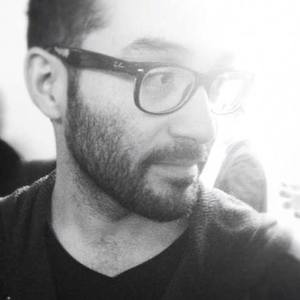Asheville-based figurative watercolor artist Reuben Negron explores the human experience with intimate nude portraits
BY JOHN C. TRIPP
This interview was conducted during Summer 2015. View more recent works by Reuben Negron at his website.
Reuben Negron will be part of Asheville’s Blue Spiral Gallery’s Into the Blue – Artist Invitational 2019, opening January 11 – March 2, 2019.
Asheville is a relatively new home for Reuben Negron, who relocated here just a year ago from his base in Connecticut and New York City. He could’ve chosen to live just about anywhere, since his work is internationally recognized and he regularly shows in New York City, San Francisco and Miami. But Negron was ready for a change, and Asheville fit the bill. Asheville’s vibrant community, its food, natural setting and low cost-of-living compared to major cities, as well as its relative proximity to New York were key factors in Negron’s decision to move here with his wife and daughter. So far, Asheville has been everything Negron had hoped for, a city with a more relaxed pace, and time to focus on his art, with the city revealing itself in new and interesting ways, much like his body of work.
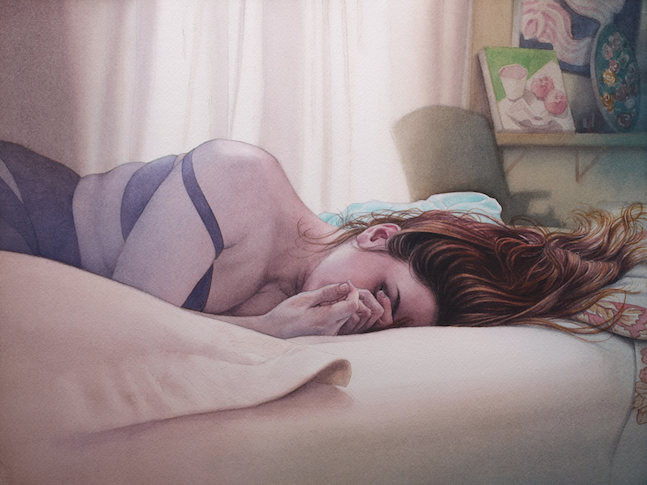
Though he’s yet to fully immerse himself in the city’s art scene, Negron is enthused to be here, and of the idea of his intimate and beautiful nude portraits being shown in the city. His work is an open dialogue on the human body, at its most revealing and telling. Negron tells stories with nudes, but invites the viewer to fill in the narrative, giving clues and body language that can be interpreted in many ways. Cues come from body language, setting, lighting and props, not unlike a stage. It’s up to the viewer to interpret what’s going on in his work, which is rich with detail and nuance and open to interpretation.
His latest series, This House of Glass is an intimate exposé on what we keep hidden from others – and in many cases, what we hide from ourselves. Working with volunteers, Negron interviewed each model about their lives, personalities and history; specifically focusing on sensitive and vulnerable details they normally keep veiled. Through this process their personal narratives were dismantled and reconstructed into Negron’s work. Staged in the model’s own home or place of special interest, each painting is a cumulative experience not meant to document a singular instance but to illustrate the entirety of the model’s story. Truly profound and moving works of art, both in their orchestration, and revelation.
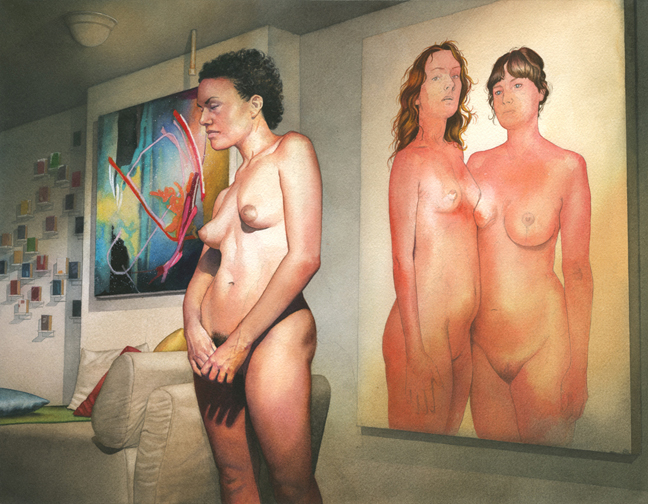
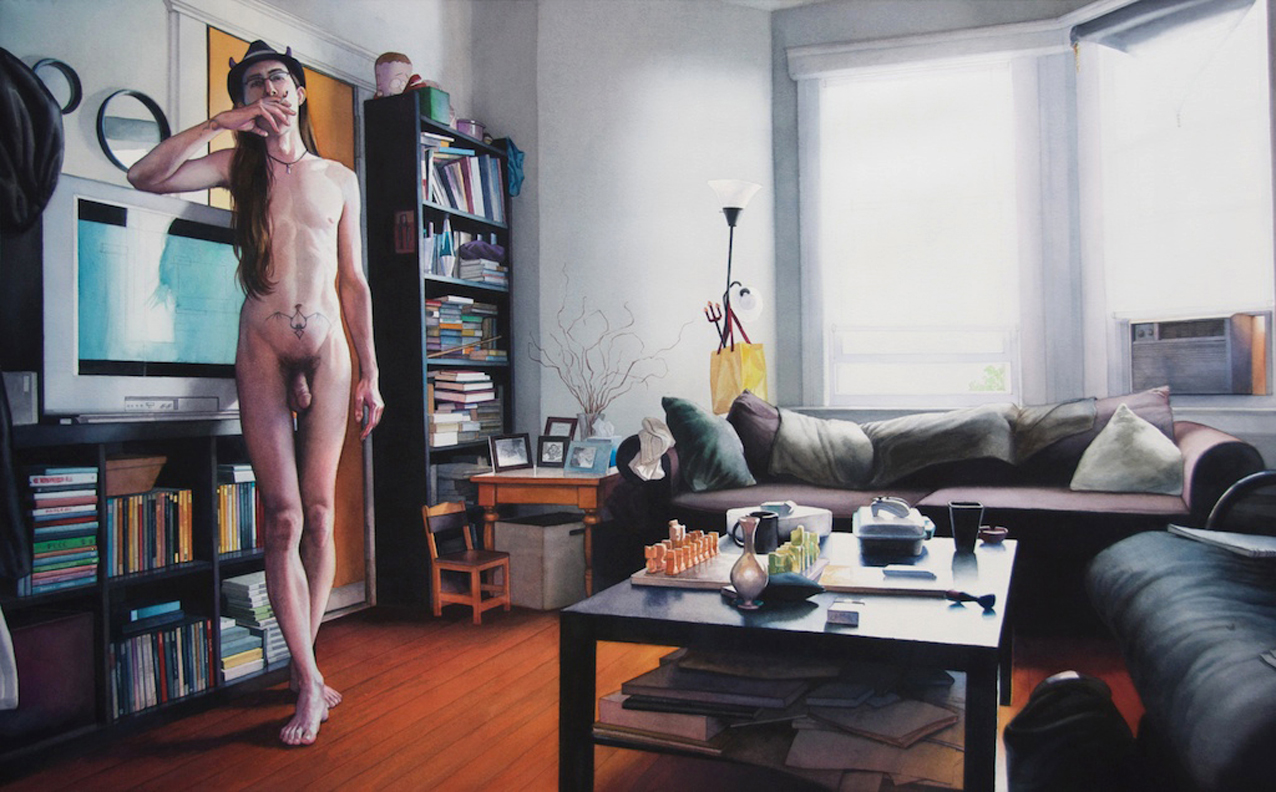
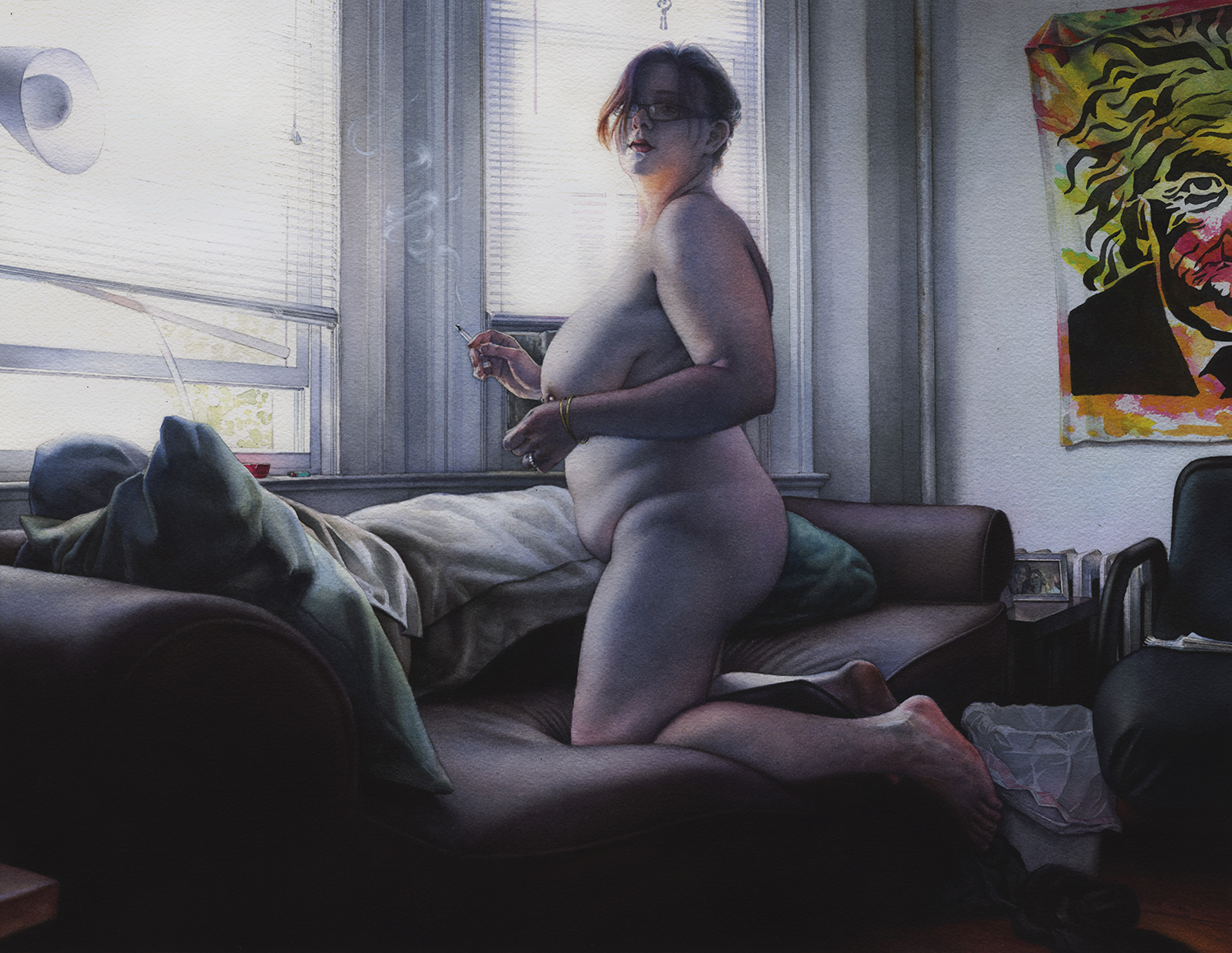


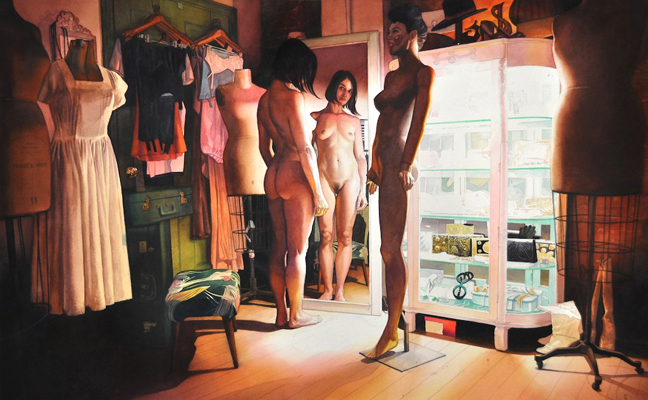
Negron is a welcomed addition to Asheville’s art scene. He may be new here, but he comes with an accomplished academic and professional career. Negron holds a BFA from Maryland Institute College of Art, in Baltimore, and an MFA from the School of Visual Arts, in New York, and exhibits nationally and internationally. He has been featured in numerous art and culture magazines, including Poets & Artists, Juxtapoz and Lost At E Minor. Negron’s recent exhibitions include two watercolors at Philip Bloom Gallery as part of Undressed, a group exhibition of contemporary nude and erotic works. He also contributed a piece to “Bad Dads”, a Wes Anderson tribute organized by San Francisco’s Spoke Art and shown at at Joseph Gross Gallery in New York City.
As a new-comer to Asheville, Negron has hopes of finding the right gallery for his work and has already made connections with local art curators and will be showing at next year’s “Erotica Asheville.” Still settling into a new culture and place, he is in the beginning stages of a new series that will encompass ideas influenced by his new surroundings.
Metro Asheville Editor John C. Tripp met with Reuben Negron on a hot, humid summer’s eve in downtown Asheville to discuss his work, relocation to Asheville and what might be next.
Metro Asheville: So, you’ve been in Asheville a year then?
Reuben Negron: Yeah, we moved down here from Connecticut a year ago after only visiting once.
MA: No kidding. You fell in love with it or what?
RN: I’ve been wanting to leave New York for a while. I have a wanderlust and I’d been in New York too long and I wanted to just go and try something new. But then I met my wife and got married and had a little girl, so for a little while we were playing it a bit safe. When she turned five years old I was like ‘that’s it, we’re out of here!’
MA: How did you choose Asheville?
RN: I’d actually spent a year traveling to different places, trying to figure out where our next home would be and last May we came down to visit some friends that moved here from San Francisco a dozen years ago or so. Neither my wife and I had ever been here before and we came down for the weekend and just realized that Asheville had a lot of what we were looking for, which included nature, a lower cost of living, and access to good local food. Just a healthier lifestyle than the Tri-State area. So, we just took the plunge and we did it. We figured we’d give ourselves a year, see what would happen and if we liked it we’d stay and if we didn’t we’d just pack up and move somewhere else. And we’re staying.
MA: That’s good news. So, you didn’t necessarily think like ‘I gotta go some place where I can show my work?’
RN: It was definitely a consideration. I needed to be somewhere where I could get to New York easily. So that meant either staying on the East Coast or going somewhere else on the West Coast; somewhere with a major airport so I could fly if need be. And where we are right now works. I’m actually heading up to New York next week. I’ve already gone – I went up in March. I’ve flown and I’ve driven and it’s pretty easy to get there. You can do it in one day.
MA: You can do it in about 14 hours right?
RN: Actually, if the traffic’s OK you can do it in less. It is pretty conveniently located. And also, another thing I do is try to get down to Miami every winter for Art Basel. So, we’re at a half-way point. It’s 12 hours up to New York, 12 hours to Miami. Same time if you fly, same cost if you fly. It’s a pretty convenient place to be. As far as moving to a place I can show my own work, I wasn’t really concerned with that as much because I didn’t want an art market that would take my work to dictate where we moved to. That would limit us too much. I would basically be in New York or I’d be in L.A. And we didn’t want to be in a major city. So, I had to throw that out right from the get go and just move to a place where we would be happy living, not necessarily where I would be able to show my work. And actually, I will be showing my work here next year with a show that’s going to be coming up. This past year there was the “Erotica Asheville” show. Did you go to that?
MA: Was it at a gallery?
RN: It was at a rental space, the Loft, next to Mellow Mushroom. Zachary Rains put it together. He’s an Asheville native and he wanted to showcase another side to Asheville artists. So he put together this erotica show in January and all of the proceeds from the show actually went to the Western North Carolina AIDS Project. They were able to raise a couple thousand dollars from the ticket sales and it was great, it was awesome. I got to meet Zachary that way. He wants to make it an annual thing so the next one is going to be in February and I’ll be involved with that which is going to be great. I’m going to try and bring in some other artists that I know from New York and California. I’m really looking forward to it.
MA: Right now do you see Asheville as a place where you would show? Because you’re already tapped into what’s going on.
RN: You know what? I would love to show here, but I’m a little embarrassed to admit that I just don’t know the art scene here that well yet. My busy season for freelance work is the summer and last summer when we made the move down here it was such a huge move for us because we were so rooted in the Northeast. We really had a lot that we needed to take care of in order to finalize the move and make it happen. I took off from work for pretty much the entire summer. So, when we moved here and I got my studio set up again I pretty much locked myself indoors for five months straight. And by the time I came up for air it was the fall and winter, and we had people visiting us and it’s just one of those things where one thing leads to another. You get caught up in the daily routine of life and just surviving and you don’t get to go out and explore your front yard. So, I’ve gone down to the River Arts District a bunch of times. And I’ve met a few artists here. But as far as the galleries I really haven’t done a good job of getting out there and exploring. Which is something I hope to change now.
MA: So, you participate in a lot of group shows and you’ve got this “Bad Dads” show coming up in New York, right?
RN: Yeah, “Bad Dads Six”. That’s the one that is opening up in New York next week. That’s going to be a pretty fun show. It’s an art show tribute to the films of Wes Anderson that was started by Ken Harman who is the owner and director of Spoke-Art which is based in San Francisco. It was actually one of the first shows that he did, and it was such a huge success that it inspired him to open the gallery. And they’ve been doing it every year since. It’s amazing, I read that it got 50,000 R.S.V.P.’s and the only way that they had promoted it was by making it an event on Facebook. All for a gallery that’s going to be able to handle a couple hundred people, max.
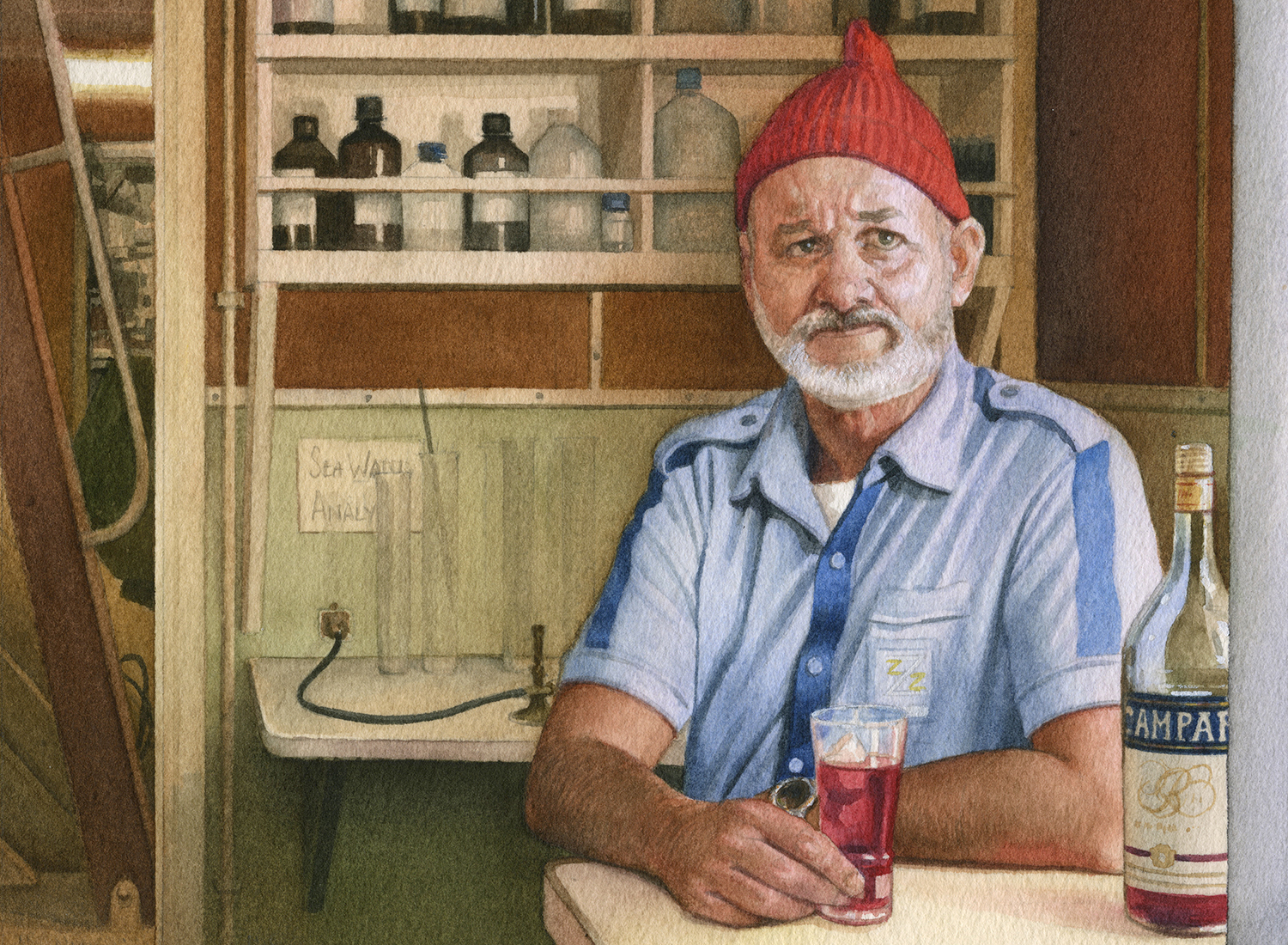
Son of a bitch, I’m sick of these dolphins
Created for Spoke Art’s eighth annual Bad Dads – An art show tribute to the films of Wes Anderson.
Watercolor on paper
6″ x 8″ (15x20cm), 2017
MA: Maybe they should rent a stadium or something, make it a stadium art show?
RN: Yeah, well there were concerns about crowds, so they ended up having to issue tickets in order to reserve places because the gallery can’t handle that many people. In New York they’d be shut down by the fire marshal like that. So, they ended up selling tickets and that sold out after two days. The tickets are inexpensive, or even free. They were just charging for Friday, which is opening night and I think it was like five bucks, Saturday and Sunday were free. It was just a way for them to track how many people showed up. But that’s great and that’s going to be a really fun show.
MA: What is your contribution, what is your piece?
RN: I did a piece inspired by Hotel Chevalier, which was a short film prologue to “The Darjeeling Unlimited.” It’s just Jason Schwartzman and Natalie Portman in a hotel room in a short, fourteen minute film. A lot of my work is focused on couples and relationships, especially showcasing and featuring people in intimate settings or in their own home, so, I kind of took my sensibilities from what I’d been doing over the past couple of years and applied it to the movie. I took the characters and the place and the props and kind of made my own version of Hotel Chevalier set in that hotel room. It is my idea of what happens after the movie ends. There’s a lot of stuff that’s implied that isn’t said in the short film. I wanted to show what was maybe three hours later.
MA: Your work is stunning. The realism and the subject matter. I love the intimate settings that it’s very beautiful but also honest. When you’re naked, you are not hiding anything, you’re showing it all, and I think your work expresses that.
RN: Well, thank you.
MA: In my opinion, anyway, you don’t have to read a strong narrative, it’s just people in their basic nudity and innocent state, their most exposed state. There’s one, in particular. And I’ve been with women like this. They’re rotund and voluptuous, and they don’t have the perfect body but they’re so beautiful. There’s one of your pieces that has a woman smoking a cigarette.
RN: I know the one, she’s on the couch by a window…
MA: And there’s also one with a woman on the bed, surrounded by prescription bottles, and she’s got a little walker.
RN: Yeah, a little cane.
MA: That was something I noticed about your work, there are visual clues that allow you to form your own story.
RN: Exactly. I never want to come out and just bang you over the head with the story. I feel like there’s so much of that. There’s so much that’s just blatant imagery. The images that I like the best are the ones that include the viewer as finishing the image, finishing the story. And that’s what I mean to do, to create these ambiguous narratives that the person looking at it has to finish. The past couple of years, the series I’ve been working on, “This House of Glass”, which both of those pieces you mentioned belong to, the whole point of that series was to do something that was natural but at the same time designed and purposeful. And, to tell that narrative, really, to get the viewer involved in someone else’s life, I had to create an interaction between the subject and the viewer through these visual clues in the painting.
MA: And that could be a myriad of conclusions.
RN: Exactly.
MA: It could be ‘this is erotic,’ ‘this is dark,’ ‘this is beautiful’.
RN: Yeah, and I’ve talked to a bunch of people who view all of my paintings very differently. It’s always interesting for me to hear their takes on them, because I feel like it’s always speaking about them as much as it is about the painting, you know?
MA: It’s what’s in their head.
RN: Yes. What are their own personal experiences, their own personal feelings towards something in that painting? For “Aida,” the woman on the couch smoking the cigarette, I’ve had such a spectrum of responses to her. I’ve had women come up to me who think I am portraying them. And then I’ve also had people who anonymously write to me saying that they feel disgusted by it. And I’m just like ‘wow, this is crazy!’ And it has everything to do with the viewer. Because the image doesn’t change, that’s done.
MA: That’s probably one of the greatest things about your work is that you don’t know how they’re going to respond.
RN: No, you never know. Some people have been completely offended by some of my work and some people think it’s beautiful and it’s touching. I never know how people are going to react.
MA: Let’s talk about Asheville in that respect. You know Asheville is a liberal city but it’s also conservative. If you leave this town you’re in a rural mountain environment. Have you ever considered the response that people might have to your work here?
RN: I’m interested to see what it is. I do paint the work that I do, in order to promote dialogue and elicit a certain response. But I’ve never ever, ever wanted it to be for shock value. I’ve never wanted it to be gratuitous and I am extremely curious to see how my work would be accepted, or just what the response would be here. But at the same time, I am a little concerned because the purpose of the work is not to shock and awe. It’s really for consideration and I’m really eager to get it out there and see how it’s received because I don’t want it to be dismissed because of its content. I don’t want it to be dismissed simply because it’s a nude person. Or there’s a full frontal nude man. And I think that there are a lot of people who will automatically dismiss it because of that. And this isn’t necessarily here in Asheville, this is everywhere. The images that I have that run into censorship online more times than not… nine times out of ten, if it showcases a nude man it will be deleted.
MA: Show whatever you want, just don’t show frontal nudity on a man.
RN: Exactly. It’s such a double standard. I can go ahead and post the exact same position, one a man and one a woman with full frontal nudity and the man will be deleted nine times out of ten and the woman will stay on. This just happened to me last week on Instagram, where even though they’re supposedly changing their policies on art and nudity in art, if someone reports it, someone reports it. So, I’ve got people on Instagram that are following me from all over the world and I have no idea who’s reporting it, but that’s just the reaction that people have. So, while I would be more accustomed showing my work in New York because I know New York, I know what’s going to happen when I throw up a painting of a nude man on a wall, I am curious to see what would happen here. And it doesn’t necessarily have anything to do with conservative morals, ethics or politics. It has more to do with just being a new place and knowing that I already get that response anyway from an international audience. So, we’ll see.
MA: Because, you know, Asheville has had these gatherings where women take their tops off. And they actually changed the obscenity laws so now if you expose your breasts you could be arrested.
RN: Wow, when did that happen?
MA: This year. So, you can’t even show your boobs.
RN: But it’s OK for a guy.
MA: Last week I was going up Biltmore Avenue, it was night time and there was a guy with his girlfriend, and she had her top off and she had these enormous breasts and she was just walking down the street without a care. It was great, an “only in Asheville” moment.
RN: I kind of like the “free the nipple” thing that’s going on right now where there are nipple pasties that people are putting on their photos. It’s hilarious, because supposedly the nipples are from a guy and you can kind of tell that they’re from a guy because you can see little strands of chest hair around it, but it’s cropped in real close so it’s just a nipple. The idea is that, if you put these over a female nipple, you still see nipple, but it’s a guy’s nipple so it’s OK. It’s just really funny, talking about the double standard.
MA: There are some things that I personally enjoy online that’s more, I guess, sexual in nature but it’s still human form. Tumblr, in particular, sites like “I Shot Myself,” which is people photographing themselves nude. Does that flow into your work, what do you think of stuff like that? Is it narcissistic, is it raw or do you not even really care about that.
RN: No, I do care. I have personally never been able to do a self-portrait. I’ve tried but I find it extremely difficult. And for me it isn’t so much a narcissism kind of thing, or an insecurity kind of thing. It’s that I can’t self-analyze that well. I admit it. I can meet someone, I can talk to them, I can hear their story and I can go ahead and figure out how to make a painting out of it. I can’t do that for myself, I don’t know exactly what I want to portray. So, I have a tremendous amount of respect for people that do self portraits, whether they be painting or photography. I’m sure that there are a million different reasons for taking self-portrait nudes and putting them online. I’m sure that some people do it for self-empowerment, for self-exploration, defining and exploring their identity. Some probably just do it for the attention, the validation through comments or appreciation. Whatever the reason is I say, ’hey, more power to you’. I can’t do that, but if you’re doing that, ‘more power to you,’ you know? Whatever the reason is, if that’s what you want to do, you found a venue and you found a way to express yourself and find whatever it is, or search for whatever it is you’re looking for, hell go for it.
MA: I’m intrigued and fascinated by the human form in all shapes, nature is crazy with all of the variations it comes up with.
RN: I am too. It’s one of the things I like most about the self portrait stuff. If you look at porn, there’s no real variety in it. There is, but you really have to get into fetishes, you need to get into niche genres in order to find what you’re looking for. But even within those niches there’s still going to be a homogeneous look, because that’s what sells. That’s what people expect, that’s what people push. So I like the fact that you see way more variation of body type, and you see way more variation in lifestyle and identity or gender identity in that, “I Shot Myself” realm than you do in any kind of professional pornography. It’s too polished, too clean, too perfect. Real life isn’t like that, there are scrapes and bruises and pock marks and stray hairs.
MA: So, let’s tie that into your work, how do you convey that with what you do. Because your methodology is so intricate, it’s so real but you also want to show some of the grit. Do you smooth it over at all?
RN: I’m using watercolor, so there’s a certain limit to what I can get away with the medium itself. It’s not like oils where I can really get into layering of texture on top of texture, like Lucien Freud would do. But his paintings are so thick because of the way that he would build up the mass of the people. I try to do that in watercolor, but because of the way I do it, it tends to smooth out. So, while I don’t ever purposely alter the model’s body, it’s a drawing, it’s a painting and there are going to be some discrepancies. But I only ever work with people who are not professional models. Every one is a volunteer and everyone is a normal person. That is your nurse, or your cashier at a grocery store, or your car mechanic, you know? So, in and of itself, the body types vary. There’s a certain level of vulnerability that they’re asked of in order to make the work possible. Unfortunately, a good side and a bad side of what I do is that because everyone is a volunteer, I’m not seeking people out for their body type or because of their story. It’s all people who have come to me, which makes the work, at least in my eyes, more genuine. But at the same time it’s very limiting, because I work with the people who are actually confident enough to do it. I’ve had people who say my work is “pretty,” that the people I choose to paint are good looking. First off, I don’t choose them, they choose me. Every single one has come to me and said, ‘hey, I want to work with you’. So, it’s not a choice. I would love to paint a wider range of people, it’s just I haven’t had those people come to me.
MA: Why not seek them out?
RN: You know, I started seeking people out in the beginning but I felt my interactions with them were too business-minded even if it wasn’t about money. See, vulnerability is a really big part of me being able to paint these portraits. I interview people about their lives, and once I get a really good handle on them, either who they are or what they want to depict in the painting, I work with them in their homes and photograph them. I’ll shoot 300 photographs in the course of a day, spent just working with that one person. It typically takes that long for them to become comfortable and for me to figure out what their body language is and just for us to become acclimated to one another. So, of these 300 photos I’ll take ten and I’ll composite them together in order to make the painting. I’ll take the little details from the cane or the bottle and I’ll add that in. Maybe there was a look in their eyes that I wanted to get, so their eyes would be from one photo, the position of their hands would be another, you know? So, there’s a lot of vulnerability and openness that needs to happen making these paintings. And in my previous experience when I was actively seeking people out or using professional models, that wasn’t there. There was a professional wall.
MA: Maybe they had a pre-determined idea of what they wanted to project?
RN: Yeah, there just wasn’t that realness that I am trying to capture. I didn’t want it to be staged, so I stopped asking people and have just had better experiences with volunteers
MA: So, now that you’ve been in Asheville for a year, and a new-comer to North Carolina, what is your impression of the South’s visual culture? Is there anything that inspires you, like naive folk art, the geography of the mountains. How does that affect you? You clearly came here to be in a natural setting, is that going to impact what you do in the future?
RN: I’m still soaking it in and I don’t want to say too much about it because I definitely have a couple things that I’m mulling about at the moment. When we moved here a year ago I knew that I was going to be finishing up the concept that I’d be doing the past couple of years: interview-based, psychological, sexual and sexual-identity based portraits. I knew I was done with that. I’m actually finishing up my last couple of pieces based on that series right now. It just takes so much time even though I made the decision a year ago. In the past year I’ve really been drawn to folklore, the setting of the mountains and the landscape, history, and just the idea that there are so many places that are abandoned. They’ve been there ten years, they’ve been there 50 years, they’ve been there 100 years, whatever it might be. Dilapidation is incredible. Coming from New York and Connecticut, I grew up with the whole “broken windows” idea where if you’ve got an abandoned building, it’s either turned into a parking lot or a high rise is put in its place. There’s constant turnover of space. Here I’ve been so intrigued by the constant push and pull with nature and the existence of forgotten locations. That’s something I’m going to be incorporating into my new work, which I’m starting this fall. I don’t want to get too into it, because it’s going to evolve and change. But I’m absolutely intrigued by history, the push and pull of nature, development, and story. So, all of that is going to be incorporated into my new stuff.
MA: That’s perfect for this region because there’s tremendous history here and nature has a big play in that. There’s all of these old homesteads that are just sitting there and its like ‘what happened to these people?’ And the plants have taken it over.
RN: Yeah, whereas in Connecticut you have to go hunting for those. You’ve really got to go looking for it. I mean, I live in Oakley and even there, there are all of these awesome, crazy structures where nature has completely taken over buildings that are just hanging out. And its like ‘how am I going to get in there? How is this going to be a part of my work?’ Because I want it to be. That really goes back to my interest in narrative. Everything that I’ve been doing up to this point has always been viewer participation narrative and I’ve got these structures and these places here in the Blue Ridge Mountains. I don’t know right off the bat what the story is, I could probably find out, but it’s much more fun to let my imagination run wild. It’s not necessarily involving people’s personal stories, it the story of place.
MA: So, you are potentially moving beyond just portraits?
RN: Probably. Place has always been a really big part of my work. I’ve always thought that the rooms I’m painting are just as important as the people. There are no two settings that look alike. Just the furniture that populates a room, the lighting, architectural elements, everything is so different. I don’t know if other people get this – but growing up in New York, those steam radiators. If I put that in the corner of the room, that’s a New York apartment building. And then if I’ve got baseboard electric, it’s somewhere else. There are little clues like that – crown moulding or details around the window frame that can tell you if the building was put up in the 1920s or 1960s.
MA: It’ll be interesting to see what you do with that here. Do you feel that you have to amass a new visual vocabulary and become familiar with the cues here?
RN: I don’t know yet, I’ll figure that out when I start and see what happens. I might be able to do it from more of a journalistic standpoint and be objective about it or I might have to really follow a story trail and be more subjective.
MA: Are you looking for the marginal and raw? What is it you’re trying to do beyond telling stories?
RN: I’ve realized over the past couple of years, over the past 15 years or so, that I tend to paint things that are the opposite of how my life actually is or how I’m feeling at the moment. When I’m feeling really good and healthy and happy, my work tends to be very dark and moody and gritty. And the opposite when I’m depressed. If I’m in a dark place, my work tends to be lighter with a lot more color. And I’m feeling pretty good here in Asheville, so I’m guessing my work is probably going to tend towards more of the under belly. That’s just something I’ve noticed about myself. But like I said I’m going to have to see what happens.
